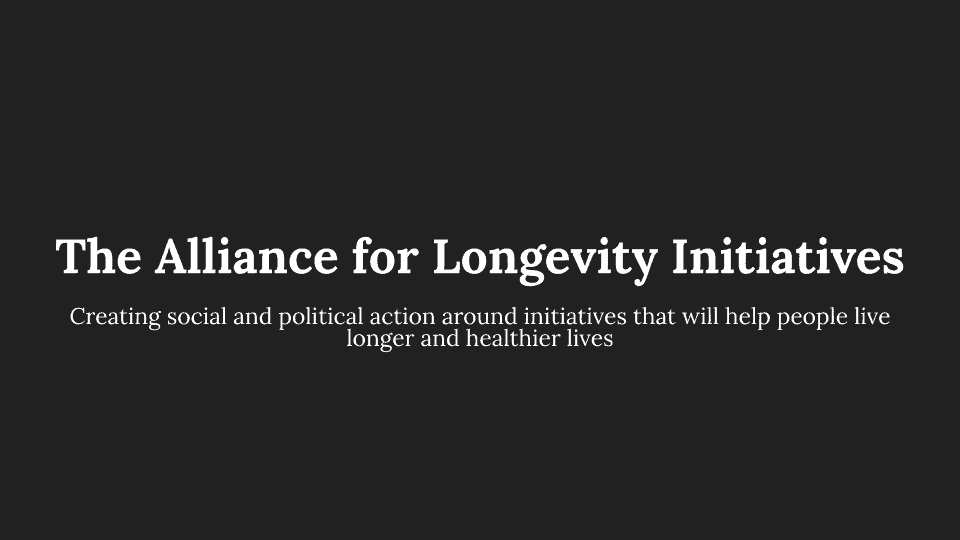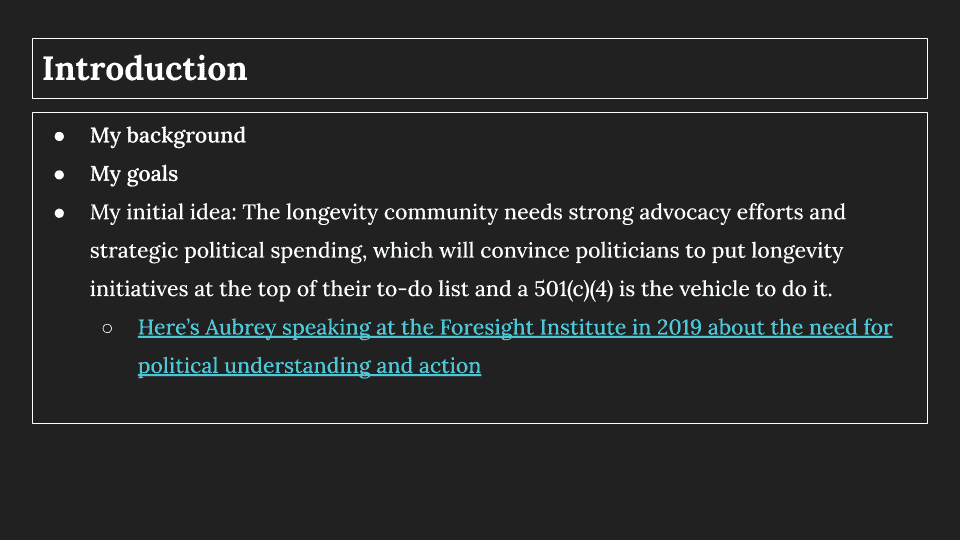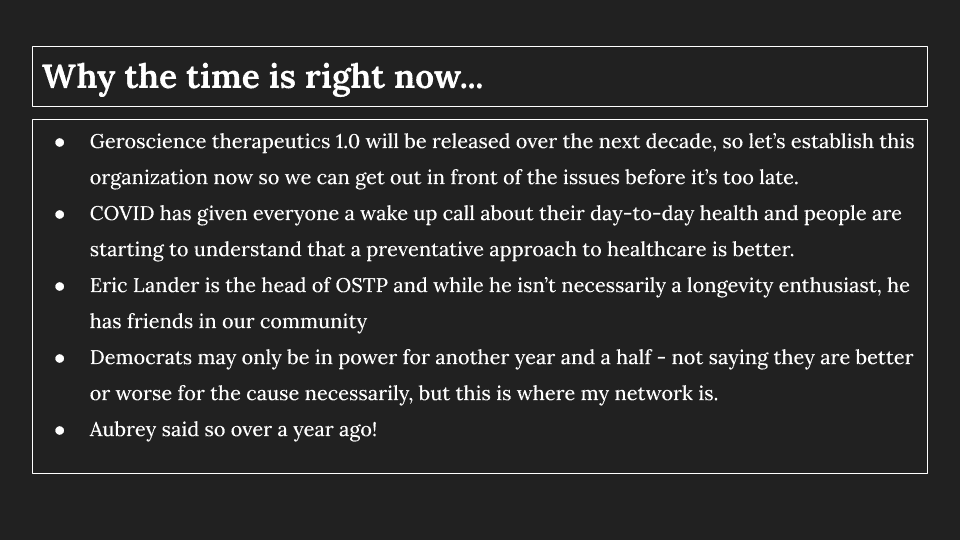Summary
In this session, Dylan Livingston, Founder and Executive Director at The Alliance for Longevity Initiatives, introduced the first 501(c)(4) nonprofit organization focused on advocating for government-sponsored initiatives and policies to increase healthy human lifespan in the US. He went over the reasons why it was needed and teased the first draft of the action plan, based on which an insightful debate took place.
Presenters
Presentation: Dylan Livingston
There are no longevity focused PACs nor political spending and 501(c)(4) are focused exactly on this.
Three specific actions to promote change – 1) persuade policymakers to support governmental longevity initiatives, 2) conduct polls and focus groups centered around longevity issues, 3) create a database of politicians
We need to build strategic relationships, set up meetings with tech and science friendly representatives, and then strategically match them with people who advocate more economically or emotionally based on their interests.
We also need lobbying initiatives similar to how the quantum or nanotech fields lobbied for their initiatives, that’s a good inspiration.
We don’t know how the public is feeling about longevity because there are not that many polls. Which is why we need consistent polling that will tell us demographics / politicians to target, so we better know how to pick and choose the messaging. For example if we find that liberal and more diverse cities are more receptive, politicians from that location will be higher on that list of targets.
Similar to how the NRA does it, so it puts pressure on members of Congress. Information on lobbying efforts for executive members only.
There is some untapped potential in relatively high ranking politicians that might be aligned with our cause. Yang has affinity to the technological sphere and responds well to economic arguments, and Alexandria Ocasio-Cortez won a prize with a life extension project in C.elegans. We should try to tap into that network while Democrats are still in power.
Memberships are the usual way to make money for 501(c)(4).
Q&A
There are similar organizations out there (both 501(c)(3) though). Creating a third organization might confuse the sponsors?
- 501(c)(3)s are limited in their political activities. You can donate or use for lobbying a non-significant amount through them, which is vague, and there is a specific limit of 20% funds used on political activity. Also you can’t endorse candidates with that vehicle. So that’s where 501(c)(4) can then pick up. With 501(c)(3) you can write off donations – so that is an avenue to get non-longevity people involved because you can write it off the taxes. 501(c)(4) is for people in this group or with vested interest. 501(c)(3) and 501(c)(4) can work together very well.
How can the organization be non-partisan, like TechNet?
- There is a history of things that can be positioned to be pitched as a unifying goal – with pitching both sides with the benefits they are prone to. Longevity is a great topic for that, because we can accentuate different benefits to different people. My network leans towards the democratic side, so anonymity of donations might be a big deal in case republican people wouldn’t want to be seen with other democrats. There are some people on the republican side that are interested in longevity, so we want to bring them in as well to the board so we are not completely biased. The economics of retirement and social security, plus the worry about insolvency of Medicare, make it very much the financially obvious thing to do and older people are older, so there are definitely ways to appeal to republicans. Real success would be finding an analogue of me with a network on the republican side.
Why not be a PAC?
- There are negative connotations around PACs, 501(c)(4) can do a lot of the same things as PACs, but then 501(c)(4) allows you to do even more and contribute more. You don’t need to name donors for example.
It would make sense to do a cost/benefit analysis of the Yang donation vs. hiring a full time person to do focused lobbying in Washington or some other focused shot. There might be higher value in lobbying directly with the feds in the office already for longevity allocation in ARPA-H. And allocation ARPA-H.
- ARPA-H in itself is a great opportunity. Biden very much wants to defeat cancer and Alzheimer’s, so we can frame it as defeating aging in order to defeat cancer and Alzheimer’s. There is a proposed $6.5 billion budget for ARPA-H. We have seen that the budget allocation is the decisive factor with NIA. Most of the budget was earmarked for Alzheimer’s. And the reasons are pretty simple: patient groups are not going to the Congress with “we are aging” but “we have Alzheimer’s”. There is a very small number of people who wind up making a decision earmarking the funds in NIH and NIA. But at the start there needs to be someone who works or worked at the relevant subcommittee, who will lobby to the specific subcommittee. This is primarily an inside job. For that we need psychographic profiles of who we need to contact and how to contact them, the right chains of people – that’s a very structured work and mapping that is necessary.
- We also need different strategies for Congress and the Executive Branch – for the executive branch is more about mobilization of scientific expertise and credibility than traditional lobbying. Most of the scientific initiatives start with a manifesto that says “We call on the Biden administration to do these things” – that’s how we need to deal with the executive branch. Like this https://www.ahlresearch.org/founders
Seminar summary by Bolek Kerous.













